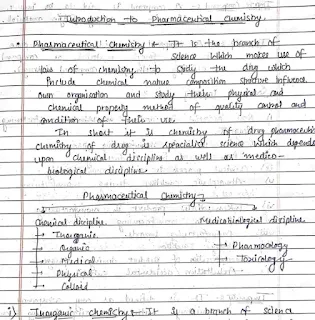Pharmaceutical Inorganic Chemistry (Unit 1): Handwritten Notes
Download these comprehensive handwritten notes for Pharmaceutical Inorganic Chemistry, Unit 1. Covering key topics like impurities in pharmaceutical substances, limit tests, and general methods of preparation and assay for inorganic compounds. These notes are perfect for pharmacy students preparing for exams or looking to deepen their understanding of the subject. Includes topics such as History of Pharmacopoeia, Sources and types of impurities, principle involved in the limit test for Chloride, Sulphate, Iron, Arsenic, Lead and Heavy metals, modified limit test for Chloride and Sulphate. Pharmaceutical Inorganic Chemistry Notes / MCQs / PPT / PDF available.
Keywords: Pharmaceutical Inorganic Chemistry, Handwritten Notes, Unit 1, Impurities, Limit Test, Chloride, Sulphate, Iron, Arsenic, Lead, Heavy Metals, Pharmacopoeia, Preparation, Assay, Medicinal Uses, Pharmacy Students, PDF Download
Pharmaceutical Inorganic Chemistry: Unit 1 - A Deep Dive
Pharmaceutical inorganic chemistry plays a crucial role in the development, production, and quality control of pharmaceutical products. Unit 1 of this subject provides a foundational understanding of key concepts that are essential for any aspiring pharmacist. This unit focuses heavily on understanding the nature of impurities in pharmaceutical substances and the techniques used to detect and quantify them. Additionally, it delves into the preparation, properties, and medicinal uses of several important inorganic compounds.
Impurities in Pharmaceutical Substances:
The presence of impurities in pharmaceutical substances is a significant concern, as they can affect the safety and efficacy of the final product. Understanding the sources and types of impurities is the first step in ensuring drug quality. This section also covers:
- History of Pharmacopoeia: A brief overview of the evolution of pharmacopoeias and their role in setting standards for drug purity.
- Sources of Impurities: This includes raw materials, manufacturing processes, storage conditions, and even packaging materials. Understanding where impurities originate from allows for targeted control measures.
- Types of Impurities: Impurities can be organic, inorganic, or residual solvents. Each type requires specific analytical methods for detection and quantification.
Limit Tests:
Limit tests are semi-quantitative tests designed to determine whether the level of a particular impurity is within acceptable limits. These tests are crucial for ensuring the safety and quality of pharmaceutical products. The notes you downloaded cover the principles behind the limit tests for the following:
- Chloride: The limit test for chloride is based on the reaction of chloride ions with silver nitrate to form a silver chloride precipitate. The turbidity produced is compared to a standard solution.
- Sulphate: The limit test for sulphate involves the reaction of sulphate ions with barium chloride to form barium sulfate precipitate. Again, the turbidity is compared to a standard.
- Iron: The limit test for iron relies on the reaction of iron ions with thioglycolic acid in the presence of ammonia to form a colored complex. The intensity of the color is compared to a standard.
- Arsenic: The Gutzeit test, a classic method, is used for the detection of arsenic. It involves the reaction of arsenic compounds with zinc and hydrochloric acid to generate arsine gas, which then reacts with mercuric bromide paper to form a yellow stain.
- Lead: The limit test for lead typically involves the reaction of lead ions with sulfide ions to form lead sulfide, which is then compared to a standard lead solution.
- Heavy Metals: A general limit test for heavy metals is based on the reaction of heavy metal ions with sulfide ions to form colored precipitates.
The notes also cover modified limit tests for chloride and sulphate, which are variations of the standard tests that may be necessary in certain situations.
Inorganic Compounds:
The last part of Unit 1 focuses on specific inorganic compounds, including their preparation, assay, properties, and medicinal uses. These compounds often serve as active pharmaceutical ingredients (APIs) or as excipients in pharmaceutical formulations. Specific examples of these compounds are likely detailed within the downloaded notes.
By mastering the concepts covered in Unit 1, you'll build a strong foundation for understanding the role of inorganic chemistry in the pharmaceutical sciences. These handwritten notes should be a valuable resource in your studies.
Info!
If you are the copyright owner of this document and want to report it, please visit the copyright infringement notice page to submit a report.

